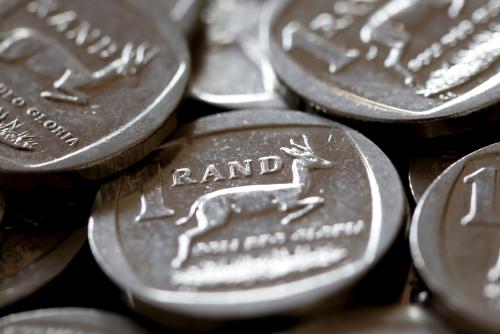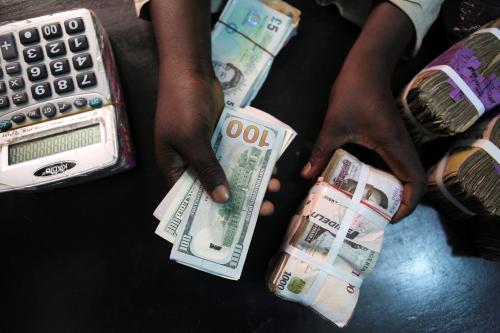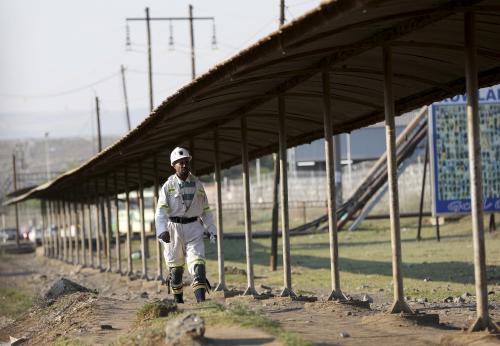The Africa Growth Initiative (AGI) Markets Monitor aims to provide up-to-date financial market and foreign exchange analysis for Africa watchers with a wide range of economic, business, and financial interests in the continent. Following the May 2016 and July 2016 updates, the October 2016 update continues tracking the diverse performances of African financial and foreign exchange markets through September 30, 2016.
We offer our main findings on key recent events influencing the region’s economies: the recent rise of fuel and metal prices, Mozambique’s and Nigeria’s credit rating downgrades, and the fall of the Nigerian naira following the June 2016 implementation of the flexible exchange rate system.
Commodity prices continue upward trend
From January to September 2016, the International Monetary Fund’s (IMF) all commodity price index increased by 23 percent, especially bolstered by mounting fuel and metals prices, as shown in Figures 1 and 2. According to the IMF’s October 2016 World Economic Outlook, the increases in fuel prices have been driven in large part by rising natural gas prices in the U.S. (due to weather trends), surging coal prices in Australia and South Africa, and gradually increasing crude oil prices, which, after hitting a 10-year low in January 2016, have risen by 50 percent to $45 in August. On September 28, the Organization of the Petroleum Exporting Countries (OPEC) agreed to reduce crude output to between 32.5 to 33 million barrels a day, increasing spot oil prices by $2.5/bbl. A final plan outlining how much each country will cut will be decided at the next group meeting on November 30. IMF projections indicate that the oil market is expected to rebalance in 2017 as demand remains strong, and supply faces a number of uncertainties including production disruptions, changing OPEC policy, and investment in unconventional oil fields.
Meanwhile, metals—lead by tin, nickel, and zinc—have experienced a 15 percent increase in prices from January to September 2016. Although metals prices declined from 2011 to 2016 as a result of China’s slowdown in commodity-intensive investment, the recent stimulus program in China’s construction sector has provided a boost to prices.


African equity markets except South Africa miss emerging markets rally
The MSCI Emerging Frontier Markets Africa (excluding South Africa) Index fell by 2.49 percent in dollar terms over the period January to September 2016, while the MSCI Emerging Markets Index has increased by 16.29 percent (see Figure 3). Figure 4 demonstrates that the emerging markets index has performed well this year, as global central bank policies have supported the demand for riskier investments, but African markets, excluding South Africa, have been largely bypassed by this trend. Within Africa, total dollar returns were highest for South Africa (14.48 percent) and lowest for Ghana and Nigeria (-13.72 percent and -34.36 percent, respectively), while Kenya and the West African Economic and Monetary Union’s exchange (BRVM) had marginal returns. The dramatic decline in Nigeria’s index can be accounted for in large part by the major depreciation of the naira against the dollar (as reflected in its local currency returns compared to the dollar returns); similarly, South Africa’s success can be attributed to the strengthening of the rand.
Ghana is in a bear market, and financing conditions for firms are dire. As borrowing costs reached a 13-year high this year, local companies are turning to equity financing to raise capital—although in Ghana’s current high-interest rate climate, investors are favoring fixed-income assets, according to Bloomberg. In Kenya, the government capped interest rates four percentage points above the central bank benchmark (10.5 percent) in August to reduce the cost of credit and stimulate the economy. Some observers thought the move would have an adverse, Brexit-like impact on the stock market and shilling, however, after an initial fall following the announcement, the market reactions have not been as profound or protracted as expected.


Global and African regional bond spreads fall
From January to September 2016, African and global bond spreads have fallen by approximately 91 and 132 basis points, respectively (see Figure 5). African bonds now have on average yield spreads 4.46 percent above the U.S. 10-year Treasury bond rate, compared with the 3.60 percent for the global bond index. Mozambique’s bond spread remains the highest in the region as it continues to deal with the repercussions from the April 2016 revelation of its $1.4 billion in undisclosed debt, as well as macroeconomic challenges exacerbated by low commodity prices (see Figures 6 and 7).



On July 8, Moody’s rating agency further downgraded Mozambique’s sovereign credit rating from Caa1 to Caa3 with a negative outlook over concerns regarding the government’s liquidity issues and the potential for further defaults on government debt (see Table 1). Standard & Poor’s (S&P) similarly affirmed its rating at the junk-bond grade CCC and revised its credit outlook to negative on August 5, estimating that Mozambique’s government debt will remain high at nearly 90 percent of GDP. In October, the International Monetary Fund reached an agreement with Mozambique to conduct an independent, public audit of loans taken out by the country’s state-owned enterprises. According to the IMF, implementing the audit quickly could help relieve fiscal pressures by expediting the resumption financial assistance to the country, which the IMF and other creditors such as the World Bank and U.K. Department for International Development suspended in April.
Meanwhile, S&P downwardly revised Nigeria’s foreign credit rating from B+ (negative) to B (stable) on September 16 based on the country’s worsening fiscal and external vulnerabilities. By mid-2016 alone, Angola, Gabon, Lesotho, Mozambique, the Republic of the Congo, and Zambia all saw rating downgrades. At the same time, eurobond issuances have fallen significantly, with only Ghana and South Africa leveraging the international bond market, according to the recent World Bank Africa’s Pulse report.

Nigeria’s naira falls after float
Figure 8 illustrates the best and worst performing African currencies in terms of spot returns from January 1 to September 30, 2016. While the South African rand, Zambian kwacha, and Somali shilling have the highest spot returns for the period, the Sierra Leonean leone, Nigerian naira, and Mozambican new metical have the lowest. The South African rand’s success this year is due in part to improvements in the current account deficit, rising commodity prices, and the prospect of low-for-longer U.S. interest rates. Still, political infighting among the country’s leaders has led to recent volatility in the rand. Furthermore, the Zambian kwacha has rallied against the dollar as copper prices have been rising, while the Somali shilling has firmed against the dollar on remittance flows and modest levels of foreign investment to the country.
Sierra Leone’s leone, Nigeria’s naira, and Mozambique’s new metical have all slumped largely as a result of low commodity prices in 2016. Sierra Leone has faced the twin challenges of the collapse of its mining sector and the lasting economic impact from the 2014-2015 Ebola crisis. Mozambique’s escalating debt has influenced the decline of the metical. For the Nigerian naira, however, the most influential factor in the currency’s trajectory has been the implementation of the Nigerian naira’s flexible exchange rate policy on June 20, 2016, which—while aiming to increase liquidity and access to foreign-exchange—has led to a shortage of foreign-exchange at banks and a major increase in the price of the dollar on the black market. Since the introduction of the float, the naira has depreciated 37 percent against the dollar (from 199 naira per dollar to 315 naira per dollar) and is down 42 percent from its 2015 level (see Figure 9). According to Bloomberg, the parallel market price for naira has increased to around 475 naira in early October compared with 425 in mid-September. In August 2016, the government began managing the float at approximately 315 naira per dollar in order to prevent further slippage, although some observers argue that the manipulations of the exchange rate are deterring foreign investment and harming import-dependent manufacturers, thus hindering economic recovery.










Commentary
AGI Markets Monitor: Rising commodity prices, Mozambique’s debt crisis, and Nigeria’s parallel exchange market
October 2016 update
October 27, 2016